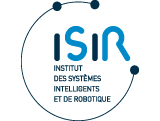A voir également
Short bio

Title : Doctorant.e
No longer in the unit
Ph.D thesis subject: Design and control of bio-inspired helical microswimmers
Advisers:
- Stéphane Régnier, Professor UPMC, ISIR, (stephane.regnier
- Nicolas Andreff, Professor UFC, FEMTOS-ST, (nicolas.andreff
- Gilgueng Hwang, Researcher, LPN, (gilgueng.hwang
Micro and nanorobots will have a great impact in medicine. They can be used to targetedly deliver chemical and biological substances, to remove material by mechanical means, to act as simple controllable static structures or to transmit biological data from a specific hard to reach location [Nelson10]. The medical context often implies that the micro and nanorobots have to swim in fluid. However, at the micro and nano scale, the fluid become extremely viscous and the Reynolds number of the micro and nanorobots dramatically lower. Purcell described two swimming techniques which are suitable for swimming at low Reynolds numbers [Purcell77]: corkscrew type rotating propulsion and oscillation of flagella. Micro and nanoscale helical swimmers are inspired by E. coli bacteria. E.coli bacteria consist of a rod-shaped head and a bundle of passive flagella. Flagella are driven by a rotary motor into a helical shape to generate a corkscrew-like motion [Berg73].
Figure1: (a) The first helical type swimmer with a cubic magnetic head [Honda96]. (b) Artificial Bacterial Flagella with a thin-square-plate soft magnetic head [Zhang09,Zhang10]. (c) A smaller helical swimmer with a spherical head [Ghosh09]. (d) Helical Nanobelt with a cylindrical tube head [Hwang10, Hwang11]. (e) A polymer helical swimmer with a "claw" shaped holder head [Tottori12].
Since more than ten years ago, researchers have developed several different micro helical swimmers, with different geometry parameters and with different head shapes (see Figure 1). The control of the helical swimmers' movement has not been clearly realized mainly due to the limited observation tools to characterize the propulsion characteristics and to identify the propulsion matrix at the microscale. This prevents their microrobotic applications which usually need to implement the closed loop control. We proposed to assemble Scaled-up Helical Nanobelts (SHNs), since the fluid is only characteristized by the Reynolds number which is a dimensionless numbers. We developed their control testbed to identify their propulsion matrices and to observe their rotational propulsion characteristics. From a methodologic point of view, we introduced a novel investigation approach which relies on adimensionality principles.
![(a) The first helical type swimmer with a cubic magnetic head [Honda96]. (b) Artificial Bacterial Flagella with a thin-square-plate soft magnetic head [Zhang09,Zhang10]. (c) A smaller helical swimmer with a spherical head [Ghosh09]. (d) Helical Nanobelt with a cylindrical tube head [Hwang10, Hwang11]. (e) A polymer helical swimmer with a "claw" shaped holder head [Tottori12].](/UserFiles/Image/xxxx.png)






